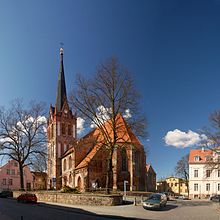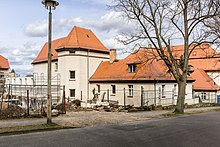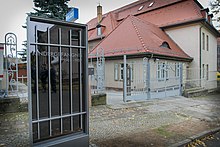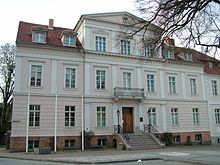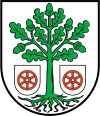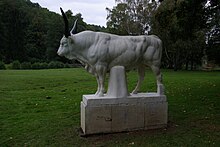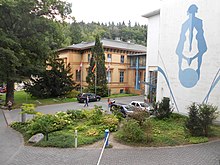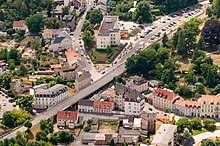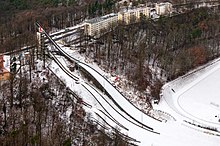Bad Freienwalde (Oder)
| coat of arms | Germany map | |
|---|---|---|

|
Coordinates: 52° 47′ N , 14° 2′ E |
|
| basic data | ||
| State : | Brandenburg | |
| county : | Märkisch-Oderland | |
| height : | 10 m above sea level NHN | |
| Area : | 131.11km2 _ | |
| Resident: | 12,286 (Dec 31, 2020) | |
| population density : | 94 inhabitants per km 2 | |
| Zip code : | 16259 | |
| area code : | 03344 | |
| License plate : | MOL, FRW, SEE, SRB | |
| Municipality key : | 12 0 64 044 | |
| LOCODE : | EN BFA | |
| NUTS : | EN413 | |
| City structure: | 7 districts | |
| Address of the city administration: |
Karl-Marx-Strasse 1 16259 Bad Freienwalde (Oder) |
|
| site : | ||
| Mayor : | Ralf Lehmann ( CDU ) | |
| Location of the town of Bad Freienwalde (Oder) in the district of Märkisch-Oderland | ||
Bad Freienwalde (Oder) (until 1925 Freienwalde , 1925–1994 Bad Freienwalde ) is a town in the district of Märkisch-Oderland in Brandenburg and a state-approved moor health spa and the northern center of Märkische Schweiz .
Geographical location
Bad Freienwalde is located on the Old Oder on the north-west edge of the Oderbruch at the transition to the Barnimplateau . This is also the reason for the extremely large difference in altitude of almost 160 m by Brandenburg standards within today's urban area.
city outline
The city has seven districts:
- old glitzen
- Old ranft with the community part sugar factory
- Bralitz
- High Seeds
- Hohenwutzen
- Neuenhagen
- Schiffmühle with the district of Neukietz and the residential areas of Neutornow and Gabow
In addition, there are the residential areas Alte Schleuse, Altkietz, Alttornow, Alttornower extension, Alttornow settlement, Oderberg/Bralitz station, mountain colony, Bergthal, Deichhof, Eduardshof, Flämmingsau, Freienwalder extension, Heeses Loos, Herrenwiese, Jungfernloch, lime kiln, Bralitz colony, Lindekes Loos , Neuenzoll, Neuglietzen, Regina, Saaten-Neuendorf, settlement, Sonnenburg , Waldhaus and Wendtshof.
story
14th to 18th centuries
The first documented mention of Freienwalde took place as Vrienwalde in 1316. Until 1369, Freienwalde was an immediate city under state rule. Between 1369 and 1375 the town was transformed into a mediat town under aristocratic authority and the brothers Heinrich I. and Arnold I. von Uchtenhagen received Freiewalde as a margravial fief . This was done in exchange for the cession of the town of Sonnenburg ( Słońsk ) in the Neumark as part of a settlement to lift a church ban. From then on, until they died out in 1618, they determined the fate of the place comprehensively, but also supported the construction of a stone church, which was expanded in the middle of the 15th century. Among other things, the von Uchtenhagen appointed mayors and councilors and determined who was allowed to act as judges and lay judges. Since they also have comparatively restrictive control of immigration to the town, Freienwalde developed only hesitantly. The nobles received income by levying taxes on the residents, but also through customs and ferry fares, which traders passing through had to pay. This condition only ended with the death of Hans von Uchtenhagen on March 21, 1618. At that time, around 800 inhabitants lived in the city, who lived from agriculture and fishing and, to a lesser extent, also practiced a craft.
In 1618, Freienwalde became the domain office of the Electors of Brandenburg . During the Thirty Years' War , the city was affected by billeting and requisitions from 1627 onwards . In addition, there was a plague that killed almost all the inhabitants. After major looting in the years 1636 and 1637, only 74 citizens lived in 1638 after the end of the plague and active hostilities in Freienwalde. By the end of the war, half of the town houses had been destroyed; the city only slowly recovered from the terrible time: in 1668, 27 of 148 town houses were still uninhabited. In 1685 Bernhard Friedrich Albinus described the healing spring discovered in 1683 (“Kurfürstenquelle” in 2019) and thus laid the foundation for the development of the town into a spa town. In 1696 the Church of St. George was built on the foundations of a previous building . An iron hammer and an alum plant were built in 1716/1718 as a result of the discovery of ferrous sands and alum .
Friedrich Wilhelm I was initially skeptical about the healing spring. But this changed when he was told in 1733 that his soldiers had recovered there. As a result, visits to the source increased; a new lodging house was built, the "Alt-Königlich". Frederick II distrusted reports of recovery after visiting the healing spring, but encouraged the well nonetheless. He had another lodging house, the "Neu-Königlich", built. From 1790, Queen Friederike Luise stayed in the city during the summer months. Their presence shaped the social life of the city for the next 13 years. After 1792, she had a small pleasure garden created in front of the city gates on the Apothekerberg, which was gradually expanded. A theater and concert pavilion was built on the hillside in 1790. After the death of Friedrich Wilhelm II , she chose Freienwalde as her permanent summer widow's residence; the castle of Freienwalde was built.
19th century
With the introduction of the Prussian reforms in 1816, Freienwalde was made the district town of the district of Oberbarnim . The city administration moved together with the district authorities into the electoral hunting lodge. In the same year, the royal fountain management reported to the king that the healthy fountain had become dilapidated. The king granted help with which bathing operations could be resumed. In 1821 the gardens were redesigned according to plans by Peter Joseph Lenné . In 1832 the city took over the property and continued the bathing business. From 1840, the applications were supplemented by mud baths. In 1850, Freienwalde was the venue of a regional court that made the constitutionally important Freienwalde arbitral award . In 1854 the city decided to build its own town hall, which could be occupied on September 10, 1855. In 1866 the railway was connected to the Neustadt-Eberswalde – Wriezen line , and in 1877 to the line to Angermünde . During this time there was an economic boom, which was also reflected in the construction of numerous villas on Gesundbrunnenstrasse, Weinbergstrasse and Goethestrasse. In 1879, the city acquired the area between Wriezener and Melcherstrasse and built new roads there. However, the specialist clinic and mud baths in Bad Freienwalde , which still existed in the 21st century, were characteristic of the town's development . Added to this were the new tasks as district administration, which led to a new construction of the administration building. It was inaugurated on September 9, 1875. In addition, on January 17, 1889, the district committee decided to set up a district museum. The discovery of clay deposits in the 1880s led to the founding of a chamotte factory and five steam brickworks. Up to 800 workers were employed there, producing over 25 million bricks and hundreds of thousands of roof tiles every year .
20th to 21st century
In addition to the economic boom, numerous retirees and retirees also settled in the town. Around 1900 there were 30 hotels and around 200 guesthouses in the city. In 1909 the Royal Court Chamber sold Freienwalde Castle to Walther Rathenau . He had the now neglected property renovated and used it for his writing. After he was murdered, his heirs gave the castle and its furnishings to the district of Oberbarnim. After the Great Depression , the city experienced a modest upswing; the number of inhabitants rose to 10,900 by 1928. In addition, there were numerous day visitors from Berlin's middle and lower middle classes who used Bad Freienwalde as a place to relax. On October 23, 1925, Freienwalde was given the official name of Bad . At the beginning of the 1920s, space was also limited in the newly built town hall. The city therefore decided to expand the attic in 1926/1927 and set up a new meeting room there.
Because wealthy Berlin Jews like to visit it as a health resort, Bad Freienwalde was described by the National Socialists as a "Judenbad" with defamatory intentions. Jews were forbidden to enter the spa district. From 1934, large barracks were built on the western outskirts of the town, through which numerous Bad Freienwalde construction companies were able to obtain orders. Within two years they erected the Hohenfriedberg barracks for the 3rd Motorized Battalion of the 3rd Rifle Regiment in Eberswalde. Meanwhile, the hostilities against the Jews continued. In 1935, for example, a wooden plaque hung at the train station with the inscription "Bad Freienwalde does not want any Jews!" In the pogrom night of 1938, the synagogue was set on fire by the Nazis . Some Jews living in Bad Freienwalde were able to flee, others perished in the Holocaust . At that time, the districts of Altglietzen, Bralitz, Hohenwutzen, Neuenhagen and Schiffmühle belonged to the district of Königsberg Nm until 1945 . in the Neumark , which largely belongs to Poland in the 21st century . At the end of World War II the interior of the castle was plundered; however, there was no massive destruction of the buildings. A total of 42 houses were destroyed by the effects of war during the Second World War. The place was evacuated on the morning of April 20, 1945, and therefore the Red Army occupied an empty town without a fight. However, numerous soldiers lost their lives in the fighting on the Oder. By 1947, 1,800 Red Army soldiers had been reburied from their provisional resting places in the district of Oberbarnim to a central war cemetery in the palace gardens of Bad Freienwalde. In addition, a military cemetery was built for the 275 deceased German soldiers next to the Evangelical city cemetery.
After the mud bath had been confiscated by the Red Army in 1950, the operators were able to resume operations in 1952 as the "working people's bath". From 1952 to 1993 bathroom was Freienwalde county seat of the same district , to October 1990 DDR - District Frankfurt (Oder) and then in the country Brandenburg . In the time of the GDR, the castle was primarily used for cultural purposes. In the 1960s, numerous VEBs were founded , including the Makosidwerk, the Vereinigte Dränrohrwerke, a factory for living room furniture and a production area of the district-managed agricultural combine. There was also a land reclamation combine, a metal cutting company, a slaughterhouse and a printing shop. In 1984, numerous apartments were built on the Scheunenberg, with which the city reacted to the now tense housing situation. From 1987 to 1989 there was initial work to rehabilitate the old town. Many dilapidated buildings were demolished.
The former prison in Bad Freienwalde at today's Adolf-Bräutigam-Strasse 4 was run from 1968 to 1987 as a "transit home for youth welfare in Frankfurt/Oder". Children and young people who were waiting for a home should be accommodated there for a maximum of 18 days. However, this maximum duration was only rarely observed; many inmates were locked up there under inhumane conditions for more than half a year. There was no contact with the outside world. The building was also surrounded by a high wall. The youngest child imprisoned was 3 years old. Today the building is a police station. A memorial has stood at its entrance since 2017 with the inscription “Children’s Prison – We will never forget. The children".
During the period of reunification , the first prayer for peace took place on October 31, 1989 in the Nikolaikirche with around 2000 participants. After reunification, the revitalization of the old town and the Gesundbrunnen district was one of the main tasks for the city in addition to the numerous social tasks. As a result, numerous buildings were renovated or newly constructed in the 1990s. The Walter Rathenau Foundation opened a memorial on the upper floor of the palace. In 1992, the General Hospital Society Saarbrücken built a new specialist clinic, which went into operation in 1994. On June 13, 1994, the town was renamed Bad Freienwalde (Oder) . Between 2000 and 2002, the area around Königsstraße in particular was thoroughly renovated. On December 15, 2003, Bad Freienwalde received final recognition as a mud spa. In 2011, the Albert Heyde Foundation assumed responsibility for the Oderland Museum. In 2012, the city inaugurated a memorial on Fischerstraße at the site of the former synagogue.
Since 1816, Freienwalde was the district town of the district of Oberbarnim in the province of Brandenburg and from 1952 of the district of Bad Freienwalde (until 1990 in the GDR district of Frankfurt (Oder) , 1990–1993 in the state of Brandenburg ). Since the district reform in 1993 , the town has been in the district of Märkisch-Oderland .
incorporations
- 1928: Altkietz (formerly Kietz) and Alttornow (formerly Tornow)
- 1957, January 1: Sonnenburg
- 1993, December 6: Altraft
- 2003 October 26: Altglietzen , Bralitz , Hohenwutzen , Neuenhagen and Schiffmühle
- 2009, January 1: Hohensaaten
population development
|
|
|
|
Territorial status of the respective year, number of inhabitants as of December 31 (from 1991), from 2011 on the basis of the 2011 census
politics
City Council
The town council of Bad Freienwalde consists of 22 town councilors and the full-time mayor. The local elections on May 26, 2019 resulted in the following distribution of seats:
| party/constituency | seats |
|---|---|
| The left | 4 |
| CDU | 3 |
| Voter Association 2019 | 3 |
| AfD | 3 |
| FDP | 2 |
| SPD | 2 |
| Electoral group of island communities | 1 |
| Neuenhagen Carnival Club | 1 |
| Individual applicant Katja Göcke | 1 |
| Alliance 90 / The Greens | 1 |
| Spa town for everyone | 1 |
Mayor
Ralf Lehmann (independent) has been the city's mayor since 1993. In the mayoral runoff on October 15, 2017, he was confirmed in office for another eight years with 51.2% of the valid votes.
coat of arms
The coat of arms was approved on January 7, 1994.
Blazon : "In silver, a rooted green oak tree (with 8 leaves and 5 fruits), whose trunk is flanked by two small silver shields, each with a six-spoked red wheel." The six-spoked red wheels come from the coat of arms of the von Uchtenhagen family .
town twinning
Town twinnings exist with Bad Pyrmont in Lower Saxony and Międzyrzecz (German Meseritz ) in Poland.
A large boulder bears the inscription "Stadt Bad Pyrmont", the city coat of arms (a red anchor cross) and the words "Partnership since 1990". The Pyrmonter Platz, which is the location of the memorial stone, was inaugurated together with the memorial stone. Also as a sign of solidarity, the historic Emmerbücke "An der Saline" in Bad Pyrmont was christened the "Bad Freienwalde Bridge" in 2009.
sights and culture
The house of the regionally well-known poet Karl Weise , the former Villa Vinea Domini , became known in the second half of the 19th century as the Freienwalder Musenhof , an intellectual circle around the secret court, medical and medical councilor Karl Julius Aegidi (1794–1874) and his son, the jurist Ludwig Aegidi . This group also included Paul Heyse , Ernst Haeckel , Georg Bleibtreu , Adolph Menzel and later Julius Dörr and Victor Blüthgen .
architectural monuments
Bad Freienwalde, with its historic city plan and the appearance of the city's characterizing buildings, streets, squares and green spaces, has a number of buildings and facilities worth seeing. These include the parish church of St. Nikolai and the former church and today's concert hall of St. George .
The castle of Freienwalde was built in 1799 on behalf of Friedrich Wilhelm III. Built by the secret chief building officer David Gilly on the Apothekerberg as a summer residence for the Queen Mother Friederike Luise . In previous years she had had the hill landscaped there and equipped with a small tea house (1790). She died in 1805, and in 1822 the park was redesigned by the landscape architect Peter Joseph Lenné . In 1909 the industrialist, writer and politician Walther Rathenau acquired the castle. After the murder of the German foreign minister in 1922, his heirs bequeathed the castle to the district of Oberbarnim in 1926 with the condition that Rathenau's intellectual heritage and memories be preserved here for all time. The museum was closed during the Nazi era, and in East Germany the building served as the Puschkin House of the Society for German-Soviet Friendship . In 1991 the castle was taken over by the district of Bad Freienwalde and a Rathenau memorial and an exhibition on the history of the castle were set up again. At the end of 2016, the operating Kultur GmbH was closed for financial reasons. The Rathenau memorial can only be visited with prior registration. The bel étage has been cleared and is no longer accessible to visitors.
The spa park is also worth seeing, including ferrous springs, a sundial, two marble sculptures and the Papenteich with an island.
The former Freihaus von Uchtenhagen at Uchtenhagenstrasse 2 houses the Oderland Museum.
At the site of the former Jewish cemetery on Goethestrasse , a memorial stone with a Star of David commemorates the city's Jewish citizens who were persecuted by the National Socialists . The graves and stones of Ernst Seeger (1900-1970), Erich Hannemann (1900-1970), Willi Jankowski (1906-1975), Emilie Loose (1884-1956) and Wilhelm Loose (1887-1967) can be found in the municipal cemetery ), Julius Dörr (1850–1930), Victor Blüthgen (1844–1920), Paul Hager (1859–1920), Wilhelm Hagen (1814–1890), Carl Hesse (1863–1920), Johannes Thilo (1862–1935), Rudolph Trapp (1872-1942).
Noteworthy are the Soviet memorial on the Platz der Jugend, the Karl-Weise memorial with a portrait medallion in the Karl-Weise-Straße and the high-water mark of 1947 (boulder in front of the post office).
Other buildings designated as monuments are:
- New post office, Karl-Marx-Strasse 18
- Elementary school "Theodor Fontane", Linsingenstraße 15
- “Käthe Kollwitz” elementary school, Weinbergstrasse 4
- Former lodging house "Alexandrinenbad" (today Albert Schweitzer School), Wriezener Straße 2
- former tax office, Wriezener Straße 36
- Catholic Church on Goethestrasse
- Landhaus , Gesundbrunnenstrasse
- Soviet Memorial of Honor, Berliner Strasse
- Villas on Sacred Halls
- Residential building at Bahnhofstrasse 24
- Residential building at Karl-Marx-Strasse 14
- Residential building at 4 Short Street
- Residential buildings at Neue Bergstrasse 1, 2, 4 and 31
- Residential building with Wilhelminian style shop fitting, Neue Bergstraße 29
- artificial ruin spur of vineyard
- Residential buildings at Uchtenhagenstraße 3, 13, 13a, 16, 16a, 22 and 28 (some with courtyard development and property edging)
- Residential building with property edging , Uchtenhagenstraße 13a
- Residential building with courtyard building, Wriezener Straße 83
- Observation tower on Karl-Weise-Strasse/Linsingenstrasse
No longer in the city, but belonging to the city area, are the Bismarck Tower on the federal highway 167, built in 1895 on the site of the destroyed Malchow Castle , and the former lye tunnel between Alaunwerk and Teufelssee. The waystones on the Gustav-Schüler-Weg, V.-Diemar-Weg and Kühnemann-Weg as well as on the Fürstensteig are also noteworthy. Not far from the city, on the B 158 in the direction of Berlin, is the Wollenberg bunker , which is listed as a monument in the state of Brandenburg.
The list of monuments of the district and museum village of Altranft with its historical village center with farm buildings, manor house and rural park, village church and objects of the open-air museum can be found in the corresponding article. In the district of Sonnenburg, the manor house with park and outbuildings is under monument protection. This was temporarily the residence of the former Reich Foreign Minister Joachim von Ribbentrop .
Louis Henry Fontane , the father of the writer Theodor Fontane, lived in the Fontanehaus in the Schiffmühle district .
Museums
- Oderland Museum, Uchtenhagenstr. 2 (cultural history of the Oderbruch , history of the spa and bathing town)
- Schloss Freienwalde , Rathenaustr. 3 ( Walther Rathenau memorial and special exhibitions)
- Brandenburg Open-Air Museum Altranft, Am Anger 27 (everyday life of the rural population), closed in 2015, since 2016 Museum Altranft, workshop for rural culture, from 2017 Oderbruch Museum Altranft , workshop for rural culture
- House of Nature Conservation, Dr.-Max-Kienitz-Weg 2 (museum, park and hay hotel , founded by Kurt Kretschmann )
observation towers

There are four lookout towers in the town of Bad Freienwalde. For hiking and tower friends, the tower ticket is offered for climbing all four towers and then a tower diploma is awarded.
- The 26 m high observation tower on the Galgenberg (Rundschauturm) was built in 1879 on the southern edge of the town as a war memorial.
- The 28 m high Bismarck Tower was built in 1895 on the Schlossberg, 3 km west-north-west of the town near the B167 federal highway.
- The Eulenturm is a 13 m high wooden tower erected in 2004 (located south-west of the town near the federal highway 158).
- The 32 m high ski jump tower is part of the K 60 ski jump at Papengrund, which was inaugurated in 2008 . It is also located south-west of the town on federal highway 158.
parks
- Kurpark with a marble statue of a bull by the Berlin sculptor Louis Tuaillon
- Castle park with castle, tea house and the grave of Hermann Graf von Pückler. The park was designed by Peter Joseph Lenné .
movies
- The Police-110 episode Pollen (1972) was filmed largely in Bad Freienwalde; for example, the train station, the old hospital or the state bank branch (today the Volksbank branch) were film locations. The pharmacy robbed in the film was on Gesundbrunnenstrasse. However, the city was not named by name, it is only spoken of as a small town.
- The episode False Jasmine (1990) of the police call 110 also took place in Bad Freienwalde. Outdoor shots were filmed in today's spa district (Gesundbrunnenstraße) and at the former hospital.
- The ARD documentary Rabatz-Jugendliche im Osten was filmed in Bad Freienwalde in 2005. She addresses how two young high school graduates do not want to be defeated by the Nazis in their apparently picturesque spa town.
Economy and Infrastructure
Specialist clinic and mud bath
The clinic is a rehabilitation clinic for orthopaedics, rheumatology and osteology and the oldest spa in Brandenburg.
Public facilities
The town is the seat of the District Court of Bad Freienwalde (Oder) .
traffic
The federal highways 158 (Berlin - Angermünde /Hohenwutzen) and 167 ( Lebus - Eberswalde - Wusterhausen/Dosse ) cross in Bad Freienwalde . The nearest motorway junction is Finowfurt on the A 11 , about 27 kilometers away.
The station Bad Freienwalde (Oder) was until the 1960s a regional railway junction at the Eberswalde-Frankfurt (Oder) with branches to Hohenwutzen and to Angermünde . Following closure of the last two in 1967 today only the connection Frankfurt (Oder) -Eberswalde of the will or 1,997 regional train line RB 60 Eberswalde - Frankfurt (Oder) the NEB served. RB 60 trains also stop at Altranft station .
The operator of local public transport (ÖPNV) in Bad Freienwalde is the Barnimer Busgesellschaft .
Sports
- The first winter sports club was founded as early as 1923, which operated, among other things, tobogganing , ice skating and cross-country skiing and from January 1929 the first ski jump . Within the urban area there is a height difference of 155 m , in Thuringia Oberhof for comparison 125 m. Bad Freienwalde is still the northernmost ski jumping center in Germany. There are four ski jumps on the Papengrund. In October 2003 a new ski jumping facility was opened, the main attraction there is the new 40 m ski jump. On May 20, 2017, the Bad Freienwalde winter sports club renamed its ski jump to Kurstadtschanze " Helmut Recknagel " in the presence of the namesake . It is the first ski jumping facility that bears the name of the multiple Olympic champion , world champion and winner of the Four Hills Tournament.
- Every year on May 1st, the Athleticon 97 Bad Freienwalde e. V. organized Baasee run, which leads from the Jahn Stadium via the Brunnenweg to the Baasee and via the Sieben-Hügel-Weg back to the starting point. With two laps, the distance is 25 km long.
- Also annually leads Elite C - Race Berlin-Bad Freienwalde-Berlin through the city.
personalities
honorary citizen
- August Alexis Eduard Graf von Haeseler auf Harnekop (1800–1889), from 1845 to 1874 district administrator of the district of Oberbarnim
- Wilhelm Hagen (1814–1890), merchant and meritorious town councilor in Freienwalde (Hagenstift in Hagenstraße, grave mausoleum in the Evangelical cemetery in Bad Freienwalde)
- Heinrich Adolf Eduard Leist (1797–1867), commissioner in Wriezen, honorary citizenship in recognition of his work in laying the railway from Wriezen to Neustadt-Eberswalde
- Felix von Bethmann Hollweg auf Hohenfinow (1824–1900), district administrator of the Oberbarnim district from 1874 to 1885
- Theobald von Bethmann Hollweg auf Hohenfinow (1856–1921), district administrator of the district of Oberbarnim from 1885 to 1896, 1899 district president in Bromberg , Prussian Minister of the Interior, 1909 to 1917 Chancellor
- Hermann Graf von Pückler, Freiherr von Groditz (1797–1892), senior court and house marshal in the service of King Wilhelm I from 1861, real privy councillor, senior equerry and intendant of the royal palaces, from 1887 as a retiree in Freienwalde (“House to den vier Linden" = castle park ambulance), burial site in the castle park
- Gustav von Diemar (1814–1912), retired cavalry captain D., since 1857 in Freienwalde, councilor and deputy, director of the Gesundbrunnen for many years, services to the welfare work in the town, financial support of the relevant associations
- Victor Blüthgen (1844-1920), poet and writer, important representative of children's literature, since 1881 in Freienwalde (burial place in the Protestant cemetery)
- Emil Baeskow (1844-1933), master mason and master carpenter, honorary citizenship for his services to the development of the city during the 30 years he was a city councilor and councillor
- Hans Keilson (1909-2011), neurologist and psychoanalyst in the Netherlands, as a doctor from 1940 to 1945 in the Dutch resistance struggle, after 1945 founding an aid organization for Jewish war orphans, President of the PEN Center for German-speaking Authors Abroad; Honorary citizen since February 3, 1990
-
Erna Kretschmann (1912-2001)
Kurt Kretschmann (1914-2007) for their commitment to nature and environmental protection and the founding of the "House of Nature Conservation", honorary citizen since March 2, 1999 - Siegfried Schumacher (1926-2018), children's book author, for writing and cultural work for Bad Freienwalde
- Ingrid Linke (* 1938) for her work on the preservation and renovation of the "Little Church" and her commitment to its use as a concert hall
- Willi Knoll (* 1930), firefighter and military leader in the Bad Freienwalde volunteer fire brigade, honorary citizen since June 4, 2009
- Gudrun Zander (* 1949), chief physician at the specialist clinic and mud bath in Bad Freienwalde , honorary citizen since December 11, 2014
sons and daughters of the town
- Christoph Starke (1684–1744), Protestant theologian
- Adam Friedrich von Wreech (1689–1746), Prussian lieutenant general
- Fritz Eunike (1831–1892), landscape architect
- Ottilie von Below (1837–1894), writer
- Robert von Zedlitz-Trützschler (1837–1914), Prussian civil servant and Minister of Culture
- Max Staegemann (1843–1905), opera singer, theater manager
- Alfred Blaschko (1858–1922), physician
- Gustav Schüler (1868–1938), dramatist, local poet
- Erich Raschick (1882–1946), General
- Kurt Lindenblatt (1885–1952), consular officer
- Ferdinand Friedrich Zimmermann (1898-1967), journalist and publicist, SS-Sturmbannfuhrer
- Hilde Jennings (1906–?), actress and dancer
- Konrad Miersch (1907–1942), athlete
- Hans Keilson (1909–2011), psychoanalyst and writer
- Eberhard Günther (1911–1994), in-house lawyer, President of the Federal Cartel Office
- Erwin Wickert (1915–2008), diplomat and writer
- Eberhard Dähne (1938–2010), social scientist
- Wolfgang Richter (1940–2013), solid state physicist
- Volkmar Sigusch (born 1940), psychiatrist and sex researcher
- Helmut Jäschke (born 1950), football coach
- Helge Malchow (born 1950), publisher
- Jutta Germany (born 1958), prima ballerina and choreographer
- Olaf B. Rader (born 1961), historian
- Marian Lux (born 1982), composer and pianist
Personalities associated with Bad Freienwalde
- Bernhard Friedrich Albinus (1653-1721), physician, described the Freienwalder healing spring in 1685
- Johann Daniel Gohl (1674–1731), fountain doctor in Freienwalde
- Friedrich Wilhelm von Seydlitz (1721–1773), Prussian cavalry officer
- Louis Henry Fontane (1796–1867), pharmacist, father of the writer Theodor Fontane
- Elisa Radziwiłł (1803–1834), early love of Kaiser Wilhelm I.
- Karl Weise (1813–1888), regional folk poet
- George Mickley (1816–1889), organ builder
- Waldemar Kopp (1825–1881), rector of the grammar school, writer and textbook author
- Mathilde Rathenau (1845–1926), mother and executor of Walter Rathenau's estate
- Max Kienitz (1849-1931), forest botanist and conservationist, lived in Freienwalde
- Julius Dörr (1850–1930), writer, lived in Freienwalde
- Walther Rathenau (1867–1922), industrialist and politician, acquired Schloss Freienwalde in 1909
- Gustav Schüler (1868–1938), playwright and local poet
- Max Stutterheim (1873–1936), master builder from Berlin, lived in Bad Freienwalde from 1914 until his death
- Berta Lask (1878-1967), poet and journalist, grew up in Freienwalde
- Joachim von Ribbentrop (1893-1946), Reich Minister for Foreign Affairs during the National Socialist period, ran horse breeding on the Sonnenburg manor belonging to the Altranft district
- Dimiter Gotscheff (1943–2013), theater director, lived in Bad Freienwalde
- Elen (born 1989), singer, lives in Hohensaaten
literature
sorted alphabetically by authors/editors
- Helmut Assing: Sites and Monuments of History in the Districts of Potsdam, Frankfurt (Oder) . Urania Verlag , Leipzig/Jena/Berlin 1987, ISBN 3-332-00089-6 .
- Titia Hoffmeister, Reinhard Schmook: Bad Freienwalde. In: Castles and Gardens of the Mark. 2nd Edition. Berlin 1996.
- Ulrich Pfeil: St. Nikolai Bad Freienwalde . Passau 1993, ISBN 3-930102-04-8 .
- Ilona Rohowski: Monument topography Federal Republic of Germany . Monuments in Brandenburg. Märkisch-Oderland district. Volume 9.1: Cities of Bad Freienwalde and Wriezen, villages in Niederoderbruch . Wernersche Verlagsgesellschaft , Worms 2006, ISBN 3-88462-230-7 .
- Reinhard Schmook: Bad Freienwalde. Once and now . picture book. Culturcon/Märkische Oderzeitung, 2009, ISBN 978-3-941092-30-3 .
web links
itemizations
- ↑ Population in the state of Brandenburg according to non-official municipalities, offices and municipalities December 31, 2020 (PDF file; 950 KB) (Updated official population figures) ( Help on this ).
- ↑ Milestone for recognized spa ; Märkische Oderzeitung of May 3, 2012.
- ↑ Service portal of the state administration of Brandenburg. City of Bad Freienwalde (Oder)
- ↑ a b Eduard Heller: History of the town of Freienwalde a. O.: edited according to documentary sources . Publisher of the Freienwalder Historical Society, Freienwalde 1896, p. 11 .
- ↑ a b Friedrich Ludwig Joseph Fischbach : Ober-Barnimscher circle . In: Statistical-topographical city descriptions of the Mark Brandenburg . first part, first volume. Horvath, Berlin and Potsdam 1786, p. 557 .
- ↑ Information board The Uchtenhagensche rule over the city from 1374 to 1618 , hung up in the Oderlandmuseum Bad Freienwalde, February 2019.
- ↑ Thomas Philipp von der Hagen: Historical-genealogical description of the family of Uchtenhagen . Paulische Buchhandlung, Berlin 1784, p. 29 .
- ↑ Information board founding the Freienwalder Gesundbrunnen 1681 , hung up in the Oderlandmuseum Bad Freienwalde, February 2019.
- ↑ Information board of the Freienwalder Gesundbrunnen in the 18th and 19th centuries , hung up in the Oderlandmuseum Bad Freienwalde, February 2019.
- ^ "Freienwalde Castle information board - Prussian royal castle and Walther-Rathenau memorial , hung in the Oderlandmuseum Bad Freienwalde, February 2019.
- ↑ Information board municipal self-government and district seat from 1815 , hung up in the Oderlandmuseum Bad Freienwalde, February 2019.
- ^ "Freienwalde information board from 1871 to 1918 ", hung up in the Oderlandmuseum Bad Freienwalde, February 2019.
- ↑ Information board Weimar Republic and National Socialist period , hung up in the Oderlandmuseum Bad Freienwalde, February 2019.
- ↑ Information board from the end of the war in 1949 and the GDR period up to 1990 , hung up in the Oderlandmuseum Bad Freienwalde, February 2019.
- ↑ Information board Bad Freienwalde - oldest spa and bathing town in the Mark Brandenburg , hung in the Oderlandmuseum Bad Freienwalde, February 2019.
- ↑ Bad Freienwalde: Memorial to remind of GDR children's prison. 11 October 2017, retrieved 7 November 2019 .
- ↑ Information board 25 years of construction and renewal of the historic townscape , hung in the Oderlandmuseum Bad Freienwalde, February 2019.
- ↑ Historical municipal directory of the state of Brandenburg from 1875 to 2005, district of Märkisch-Oderland. (PDF) Brandenburg State Office for Data Processing and Statistics, December 2006, p. 46 , retrieved on January 20, 2018 .
- ↑ Stadtgeschichten ( Memento from January 31, 2013 in the Internet Archive ) on the website of the city of Bad Freienwalde, retrieved September 18, 2012.
- ↑ a b c Historical municipal directory of the state of Brandenburg from 1875 to 2005. Märkisch-Oderland district , p. 42.
- ↑ StBA: Area changes on January 1st , 2009 .
- ^ Status of area and inhabitants in the info box after the incorporation of Hohensaaten. An area exchange of a street line between Hohensaaten and Oderberg associated with the incorporation is not taken into account.
- ↑ Historical municipal directory of the state of Brandenburg from 1875 to 2005. District of Märkisch-Oderland , pp. 18-21.
- ↑ Population in the state of Brandenburg from 1991 to 2015 according to independent cities, districts and municipalities , Table 7
- ↑ Office for Statistics Berlin-Brandenburg (ed.): Statistical Report AI 7, A II 3, A III 3. Population development and population level in the state of Brandenburg (each issue of the month of December)
- ↑ Results of the municipal elections on May 26, 2019
- ↑ Lehmann remains mayor of Bad Freienwalde. In: Focus Online . March 6, 2016.
- ↑ Result of the mayoral runoff election on October 15, 2017
- ↑ Coat of arms information on the service portal of the state administration of the state of Brandenburg .
- ↑ Thomas Lackmann: The future is uncertain. Schloss Freienwalde has an eventful history. But since this week it has been unclear how the castle and museum will continue. In: The daily mirror. 1 July 2016, retrieved 3 March 2017 .
- ↑ schloss- Freienwalde.de: Schloss Freienwalde closed until further notice. February 1, 2017, retrieved March 3, 2017 .
- ↑ Steffen Göttmann: Without a farewell party in retirement. Reinhard Schmook is closing the door to his office for the last time as castle castellan. In: Märkische Oderzeitung. January 30, 2017, retrieved March 3, 2017 .
- ↑ The Tower Hiking Trail on the Bad Freienwalde website
- ↑ The Bad Freienwalde Tower Diploma on the Bad Freienwalde website
- ↑ Sabine Raktitin: Bad Freienwalde's great leap. In: Märkische Oderzeitung, October 24, 2003, p. 3.
- ↑ (kth): Ski jumping legend receives title in Märkische Oderzeitung of May 22, 2017, p. 8.
- ↑ Website of the Athleticon 97 Bad Freienwalde e. V. accessed 30 April 2013.
- ↑ Honorary citizen of Bad Freienwalde




